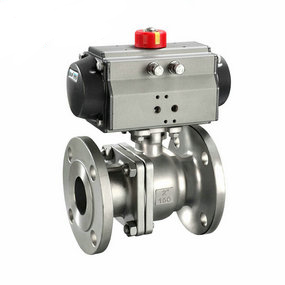Intelligent pneumatic double water cooling ultra-high temperature ball valve has low price Hardening technology of hard seal pneumatic ball valve and modified design of seal seat The balls of pneumatic ball valves are generally machined with 1Cr18Ni9Ti and 2Cr13. Their surface hardness differs by about HB217, which is not only easy to be damaged in working conditions, but also easy to be damaged during assembly or testing. We have used the method of supercooled extrusion to improve its surface hardness, and also used the method of gas liquid nitriding, chromium plating, amorphous nickel phosphorus plating, etc., but the effect and benefit are not ideal. Since last year, we have used the solid chromizing process for experiments. After one year of practical tests, the effect is very good. After chromizing, the surface hardness of 2Cr13 and 1Cr18Ni9Ti is over HV1000 degrees. After chromizing, the surface chromium content of carbon steel ball is up to 60-80 percent. Through the hanging piece experiment of the research institute, its corrosion resistance in seawater, nitric acid, acetic acid and other media exceeds that of 1Cr18Ni9Ti and 2Cr13 without chromizing. After the trial operation of 50 sets of Q41F-16C DN50 pneumatic ball valves, our factory has received good feedback from users. Our factory has determined to fully use them in cast iron and cast steel pneumatic ball valves to replace the original 2Cr13 extremely low manufacturing ball valves and gradually expand them to stainless steel pneumatic ball valves to achieve the goal of both improving quality and reducing cost.

The measured inner wall has siltation layer or the pipe wall is worn, which changes the flow area and affects the measured value. This kind of fault only occurs after a period of operation. Please refer to fault case 8.
The deviation of the upstream flow condition of the flow sensor from the requirements is mostly caused by the improper installation of the sensor in the engineering design; However, it also happened that the engineering design installation was in good condition, but after a period of operation, there was a large error. According to common sense, it seemed impossible to judge that the flow condition was poor, but it did happen. Please refer to fault case 1.




